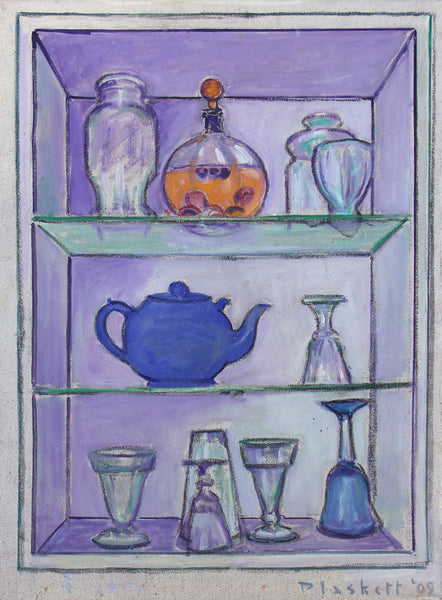Artist Q&A: Sheri Bakes

1. The title of this exhibition, ‘Open the World’ takes its name from a piece you completed earlier this year. What is the significance of the title and the particular moment that inspired it?
The title is a bit multifaceted. Externally it relates to concerns I have regarding the state of current North American and world politics, global warming, and the overall wellness of the planet. Internally as far as humanity goes, it relates to concerns I have about the wellness of humanity.
Sometimes titles come from seemingly unrelated places. This title came as I was looking out my kitchen window at a non-functioning septic tank that sat lifted half way out of the ground. The tank had nothing to do with the content of the painting but 'Open the World' was what I heard when I looked at it and the light fell through the foliage beside that area.
When something isn't working, I sit with it until it opens and the issue resolves itself inside its own answer. I'm not sure what the answer is for the planet, but I guess I'm at the stage of being open and sitting with it. Listening to the things that aren't functioning and the reality of the direction we are heading in on every level.
'Open the World,' for me anyway, keeps my mind open and gives my heart hope. I think this is something we (or maybe I) really need.

2. Do you see these new paintings as unique, or a part of a series?
Conceptually, all of my work stems back to my first show which was based on Rewach (Spirit, breath or wind). The focus on this specific quality has been consistent. My interest for each show is in constantly working to improve my craft and ability to paint. The hope is to bring something new to each show. To keep paring down what it is that needs saying at that particular time. Inside the physicality of painting, maybe a few new colours I might be working with, or variations in brushstrokes. But the basis of the work, always, is spirit, breath or wind.
3. You are well-known for your treatment of light. Can you share some observations on the light quality in Vancouver Island versus Vancouver/Lower Mainland?
As I sit here typing, the air quality in my area has been rated 10+ due to the smoke from wildfires. It seems to be the same everywhere in BC at the time this was written and while a lot of the work was being made. I do think the heat, smoke and wildfires have greatly impacted my work and ability to work for this show. I believe this has impacted some change in the work as well in terms of colour mixing choices and some choices made in application.

5. You described media theorist Marshall McLuhan’s thoughts on art “as a distant early warning system”. Could you tell us a little bit about what this means to you and your thoughts on the potential of art for personal or social change?
I really like a lot of Etienne Zack's work in terms of how it addresses instability and imminent collapse of a structure onto itself. How the networks within the paintings function as a complex maze that draw you in and make it difficult to get out before the whole thing collapses in on you. For me Etienne is a great example of an artist whose work is an early warning system. Collapse of salmon stocks. Collapse of our resident orcas (J-Pod), collapse of the glaciers, bees, all the water that Nestle is taking and selling back to us for massive profit...
I feel gravely concerned about many of the current issues our world is facing. I also have to create a light-thread of hope through that concern. To illuminate the positive things inside those very real threats.
Somehow I have to make paintings as a physical practice of gratitude. To somehow stand for, insist upon and honour the wellness of the planet.
Open the World opens on September 8 at Bau-Xi Vancouver

















































